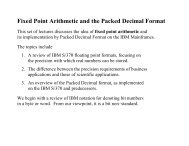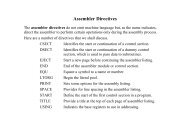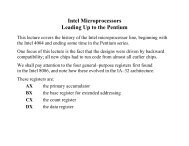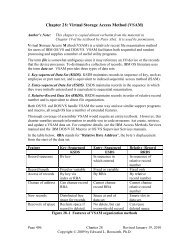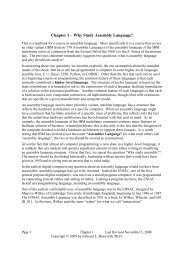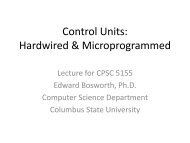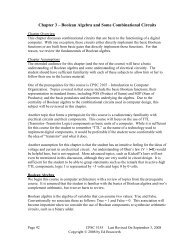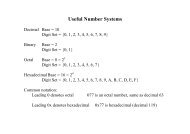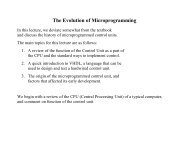Adobe PDF - Edwardbosworth.com
Adobe PDF - Edwardbosworth.com
Adobe PDF - Edwardbosworth.com
Create successful ePaper yourself
Turn your PDF publications into a flip-book with our unique Google optimized e-Paper software.
Chapter 15 Boz–7 Implementation of the CPU<br />
At this point in the design of the microprogrammed control unit, we have two distinct types<br />
of microoperations: a type that issues control signals and a type that dispatches based on the<br />
assembly language opcode. To handle this distinction, we introduce the idea of a micro–<br />
opcode with the following values at present.<br />
Micro–Op Function<br />
0000 Issue control signals<br />
0001 Dispatch based on the assembly language opcode.<br />
We have stated that there are conditions under which the dispatch will not be taken. There<br />
is only one condition that will not be dispatched: the assembly–language opcode is 0x0F and<br />
the branch condition is not met. Before we consider how to handle this situation, we must<br />
first address another design issue, that presented by indirect addressing.<br />
Handling Defer<br />
Consider the control signals for the LDR (Load Register) assembly language instruction.<br />
LDR Op-Code = 01100<br />
(Hexadecimal 0x0C)<br />
F, T0: PC B1, tra1, B3 MAR, READ. // MAR (PC)<br />
F, T1: PC B1, 1 B2, add, B3 PC. // PC (PC) + 1<br />
F, T2: MBR B2, tra2, B3 IR. // IR (MBR)<br />
F, T3: IR B1, R B2, add, B3 MAR. // Do the indexing.<br />
Here the major state register takes control.<br />
1) If the I–bit (bit 26) is 1, then the Defer state is entered.<br />
2) If the I–bit is 0, then the E state is entered.<br />
D, T0: READ. // Address is already in the MAR.<br />
D, T1: WAIT. // Cannot access the MBR just now.<br />
D, T2: MBR B2, tra2, B3 MAR. // MAR (MBR)<br />
D, T3: WAIT.<br />
Here the transition is automatic from the D state to the E state.<br />
E, T0: READ. // Again, address is already in the MAR.<br />
E, T1: WAIT.<br />
E, T2: MBR B2, tra2, B3 R.<br />
E, T3: WAIT.<br />
The issue here is that we no longer have an explicit major state register to handle the<br />
sequencing of major states. The microprogram itself must handle the sequencing; it must do<br />
something different for each of the two possibilities: indirect addressing is used and indirect<br />
addressing is not used. Assuming a dispatch to address 0x0C for LDR (as it will be done in<br />
the final design), the current design calls for the following microinstruction at that address.<br />
Address Control Signals Next address<br />
0x0C IR B1, R B2, add, B3 MAR. Depends on IR 26 .<br />
Suddenly we need two “next addresses”, one if the defer phase is to be entered and one to be<br />
used if that phase is not to be entered. This last observation determines the final form of the<br />
microprogram; each micro–word has length 44 bits with structure as shown below.<br />
Page 542 CPSC 5155 Last Revised July 9, 2011<br />
Copyright © 2011 by Edward L. Bosworth, Ph.D. All rights reserved.



